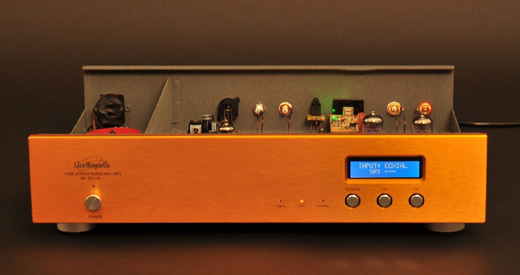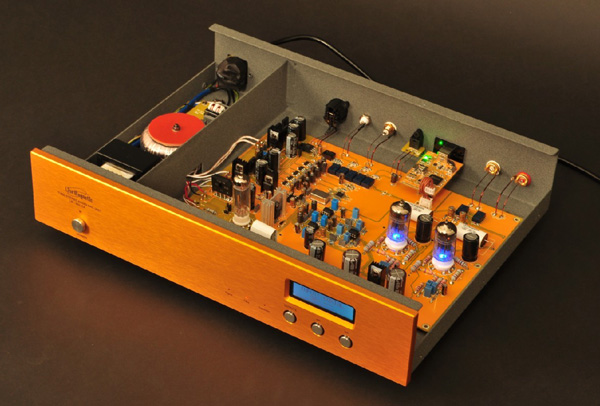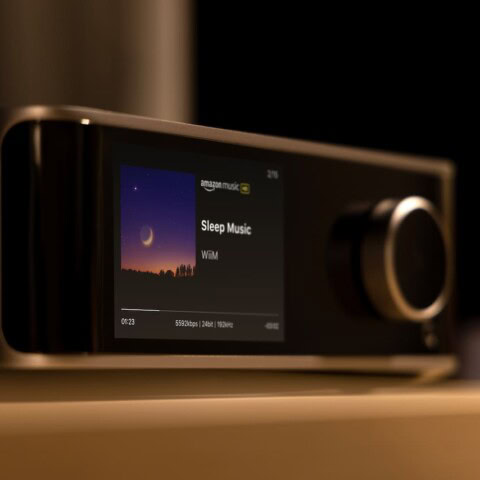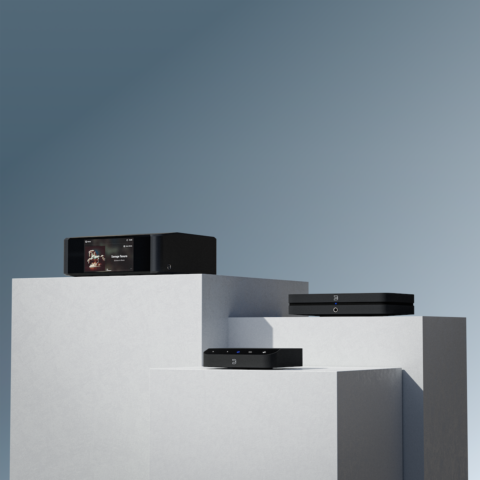$2500
5 Stars
It looks like a CD player. It can perform in both solid state and tube mode. It’s a game changer, writes Andrew Baker.
THESE DAYS IT seems everyone is jumping on the computer audio train. Like toothbrushes, there’s a new DAC/server design almost every week with bold claims regarding ultimate performance and quality. But while I’m happy to stick any old thing with bristles into my gob I have different expectations when it comes to music, so if you want to be successful in this discerning market, you’d jolly well better create something that stands up to scrutiny and actually sounds bloody good. China’s Line Magnetic have decided to have a go and after hearing some of their fabulous valve amplifiers, it was with no little anticipation that I got my hands on their current contribution to the DAC battleground.
Sometimes referred to as the “Shindo of China” on internet audio forums, Line Magnetic are rapidly making a name for themselves as the creators of highly desirable home audio equipment. With their range of great sounding retro-industrial-chic-look valve amplifiers and Western Electric speaker clones, it is easy to see why. And to show that they do indeed move with the times, they have added the LM-502CA digital to analogue converter to the family – as well as a CD player (these days more retro than valves it would seem, but for many folks a welcome addition none-the-less).
 Auckland’s illustrious audio merchants Turned On Audio very kindly supplied a unit for review, albeit only briefly – these DACs are already in high demand, with some happy listeners making the kind of favourable comments that could only serve to hurt the feelings of competitors.
Auckland’s illustrious audio merchants Turned On Audio very kindly supplied a unit for review, albeit only briefly – these DACs are already in high demand, with some happy listeners making the kind of favourable comments that could only serve to hurt the feelings of competitors.
Build & Features
The 502CA is a full sized component – 376mm x 345mm x 191.5mm (w x d h) and weighing 6.7kg with an all-metal body and a lovely thick copper coloured front plate, featuring a small LCD display window (showing the selected input and the sample rate), power on/off button and three buttons (all nice metal spring loaded types) for selecting output (tube or transistor) and input; simple, uncluttered and splendid to behold. It looks just like a CD player, but without a CD drawer. It does look lovely though.
Around the back are the usual analogue outputs and fused mains input, along with an asynchronous PC-USB input, optical and coaxial inputs, a BNC input and a balanced AES/EBU input. The USB input uses Xmos USB audio technology and utilises high speed USB 2.0 receiving and decoding 32/192 kHz signals. The company claims low distortion and ultra low jitter “clock recovery technology” with separate power supplies for analogue and digital – a Toroidal transformer for digital and EI transformer for analogue. Using a high quality ESS 9016 DAC chip, the 502CA will take digital signals from 32 bit (not that there is such a thing… yet) 44.1 kHz right through to 192 kHz (all displayed on the LCD screen). The tube analogue output stage uses two 12AU7/ECC82 valves to buffer the signal to true valve output and a 6Z4 is used for valve rectification.
 As mentioned, you can choose, at the push of a button, whether to use valve or solid state output (the signal to noise ratio is given at 92 dB for valve and 98 dB for solid state) giving users at least some ability to adjust the sound to their personal taste. Of course tube-rolling is an option too, and if I’d had a little longer I might have experimented with some of the 12AU7s from my wee collection; however, the stock valves in the supplied unit sounded just fine to me.
As mentioned, you can choose, at the push of a button, whether to use valve or solid state output (the signal to noise ratio is given at 92 dB for valve and 98 dB for solid state) giving users at least some ability to adjust the sound to their personal taste. Of course tube-rolling is an option too, and if I’d had a little longer I might have experimented with some of the 12AU7s from my wee collection; however, the stock valves in the supplied unit sounded just fine to me.
The review unit did not come supplied with a remote control. However, I am reliably informed that one does indeed come as standard issue.
An installation disc is supplied to install the driver onto your PC, which is perfectly straightforward and easy, and then you’re away.
Listening
As mentioned, my time with the LM DAC was all too brief, but fortunately it was well run-in before I got hold of it and thus wasted no time making an impression. I hooked it up to my Unison Research integrated – currently tube-rolled with some lovely military grade Brimar 12AU7 valves – and Spendor loudspeakers, using a DVD/CD player transport and my PC to supply digital signals. I have recently gone all-analogue and my trusty Rotel DAC is no longer with me so I took the Line Magnetic DAC at face value, so to speak.
I started off with the DAC set to valve output and I was immediately struck by the richness and presence of the sound – full of colour and subtle shading – and it was busy too; in an engaging, rather than distracting fashion. The soundstage was huge and spacious and images were placed precisely within it; behind, in front and to the left and right of the speakers and at various – and easily discernible – points in between. The upper frequency range was clear and detailed with crisp and speedy transients. Bass lines were rhythmic and well defined and although the bottom end was slightly on the lean side, it still brought much enjoyment. ‘Lookin’ For Love’ from Neil Young and Crazy Horse’s Zuma startled me when the backing vocals came in with such lifelike character and scale and palpable placement of the singers; guitars, too, were full-bodied and true-to-life with real finesse. The timing and rhythm on this sublime album – from the original digital release – was remarkable, especially considering that on CD it has always sounded a little restrained to me; the LM really brought it out of its shell and into the room, injecting it with life, colour and vigour, thus encouraging me to listen right through from start to end for the first time in years. I heard an occasional hint of digital “glare” but, as with vinyl surface noise, with a good player this is easily overlooked, as was the case here.
The bedroom-esque electronica of Sola Rosa’s first release, The Starter For 4 EP, contains a myriad of sounds and electronic trickery and thanks to the LMs presentation, it all floated in the air in front of me, an apparition of sound, with every subtle detail coming to the fore. The bottom end with this recording – and other bass heavy music I tried – could have been lower but it all still worked together rather marvellously, creating an immersive sonic picture with great rhythm and a nice silent noise floor and dark background. I’m sure the right speakers could compensate quite easily for that slight leanness in the bass region and I’m sure some good old tube rolling would yield positive results too. The dub-groove of the track ‘Drifter’ was intoxicating and had a feeling of presence, scale and realism which made it hard to believe this was created on keyboards and a computer in a Grey Lynn bedroom – although I believe the EP was actually recorded in a studio and engineered by the eminent Dale Cotton. (Feel free to correct me, folks.)
More electronica with Boards Of Canada’s Music Has The Right to Children, an epic and dreamy psychedelic masterpiece which, using keyboards, effects and samples, centres on ambience and atmosphere rather than bass; the sound here was spacious, textured and reminded me of swimming through thick cream after spending a consciousness expanding evening with Dr Timothy Leary (pre-death, of course). Throughout the album the band (or rather, duo) incorporates everyday background sounds; people mostly, conversations, children – even seagulls – often hidden away behind other sounds, resulting in an eerie, disarming effect. Often with the LM, these sounds and voices became startlingly, sometimes chillingly real sounding, popping out from behind a beat or becoming another layer of the sound I hadn’t previously realised. Where there was necessary bass it was tuneful and solid and, despite the induced dreaminess, got the feet moving. The music flowed freely and never became mundane, always maintaining a sense of realism and clarity that continued to surprise and inspire.
Cat Power’s Myra Lee is an itchy, often irritable blister of an album; angry driving guitars bristling with feedback and the drums sound like they’re being punished for some foul deed. The enigmatic Chan Marshall glowers behind the mic, her voice naked, visceral and honest, rising at times to an unsettling wail. It’s a hard listen, though good, and the LM gave a candid and suitably raw performance. The soundstage was wide and deep – the drums placed well back behind the speakers and Marshall just in front, with the guitars sparking and growling into the room. This is another album the LM convinced me to listen to from start to finish, despite usually having difficulty doing so – it’s not a great recording by the usual ‘audiophile standards’ but, as mentioned, is incredibly honest.
The LM-502CA played FLAC files from my laptop flawlessly, instantly recognising and displaying the different sample rates as Media Monkey shuffled through my library. One thing I find with good DACs such as the Line Magnetic is that music sounds so good that I don’t tend to concern myself with sample rates or formats – getting lost in the experience is what counts. High Definition music from my PC did sound superb, with sparkle and detail and a natural smooth flow.
There was the odd less-than-good recording that the LM DAC couldn’t quite resolve: The Good, The Bad and The Queen’s self-titled album being one in particular. This album has always befuddled me in that I can never quite pinpoint what exactly is wrong with it. It should be brilliant, with members from Blur, The Clash, The Verve and drummer Tony Allen performing some great music, but it has a certain compressed quality and there’s a vastly annoying crackling sound throughout the recording, and I don’t know if it’s intentional or not. There was still some magic to be had but to be blunt I have heard this album sound better through much lesser equipment, though obviously with great loss in other areas, and not to mention other music. For the most part, even dodgy recordings still gave something to admire and I was rarely disappointed; the Line Magnetic managed to shine new light on most anything I played.
I experimented with the solid state output, and have to say I preferred the fatter, richer and warmer sound of the tube stage. The difference was subtle in some cases, much more noticeable in others – at one point, switching from solid state to valve, the sound expanded quite discernibly; instruments gained more meat and the recording environment became more spacious. Not that the solid state mode is thin and feeble sounding by any means – it is every bit as detailed and rhythmic, and compared to many well regarded digital players the sound is exceptional and would certainly stand up on its own. It’s just that the valves added an organic warmth without inhibiting detail retrieval or rhythm and this is more to my liking. I don’t doubt there will be people who feel the other way and certain recordings will probably benefit from experimenting between the two modes.
Conclusion
The Line Magnetic 502CA is easily one of the best digital players I have heard. I’ve listened to a few high quality DACs lately but I reckon this one is a real game changer. With clarity, detail and superb timing and image separation – while remaining musical and uncluttered – it allows music’s rhythm to build naturally into a satisfying climax. It has the ability to make music sound alive and startlingly lifelike while still maintaining a somewhat refined, unforced nature. It is a great looker – pride of ownership is high – has many features and, given its performance, is very well priced. For some people, computer based audio is as daunting and stressful as trying to feed broccoli to a roomful of sugar-maniacal toddlers, but the Line Magnetic endeavours to make life as easy as possible, being easy to set up and use and, of course, sounding fantastic to boot. The 502CA still, for me at least, won’t beat out a good vinyl set up, but if I had to choose a digital source at any price, it would be high on my list without hesitation; in fact it would probably be first.
Audition one today, at the peril only of your bank balance. ANDREW BAKER















Nice review, thanks!
As with all the LM gear, changing out the stock tubes reaps huge rewards.
Wow, outperforms the dCS for you!